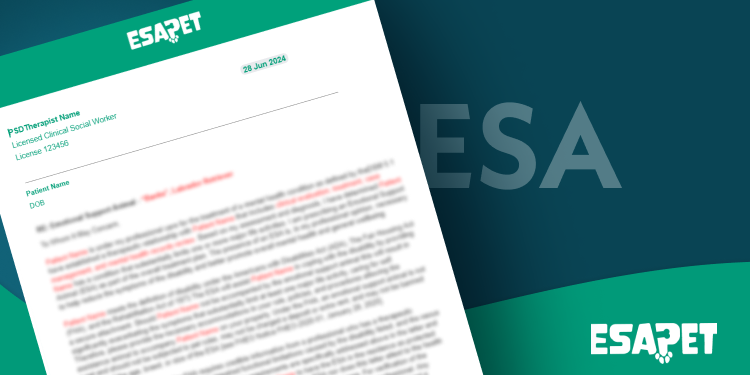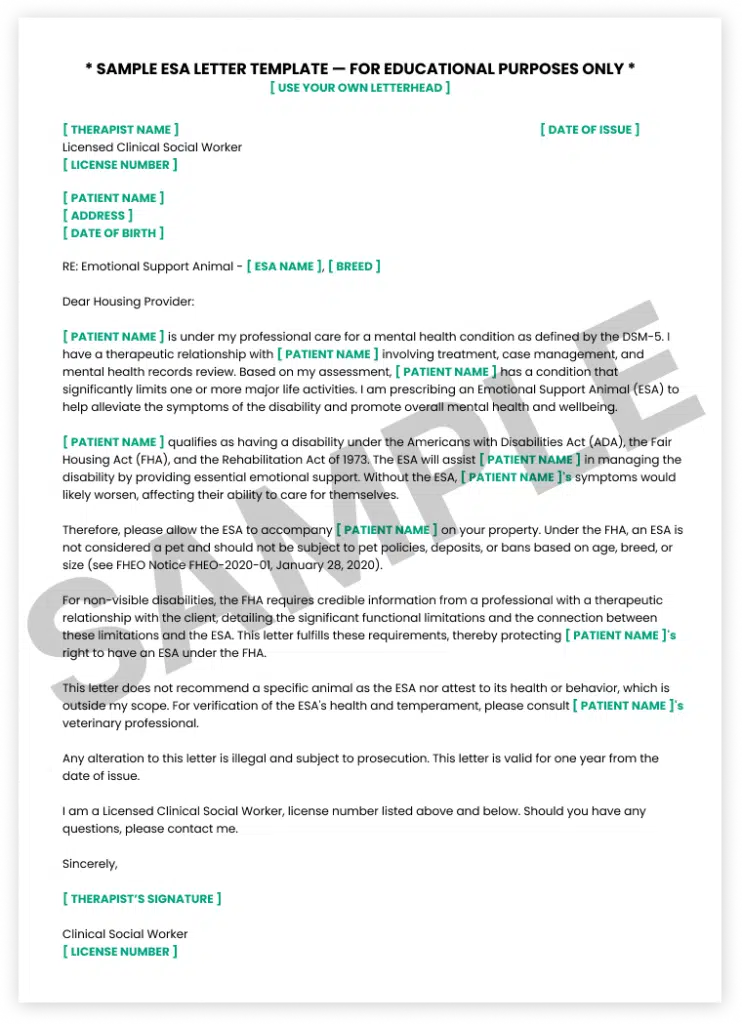ESA Letter Example: What Should Be Included?

An ESA (Emotional Support Animal) letter is an important document for people who rely on their pets for emotional support. It lets them keep their emotional support animals in housing situations.
A well-crafted ESA letter is essential for patients’ well-being. The letter ensures they have the support needed to manage their emotional health. Plus, it keeps things legal and clear, protecting both the therapist and the patient from any issues.
This article will guide therapists on what to include in an ESA letter to make it effective and compliant. We’ll also provide an ESA letter example to help you understand the format and content required.
Did you Know?
ESA letters are for housing under the Fair Housing Act. A licensed clinician can write one. It should confirm that you have a disability and a disability-related need for an assistance animal (e.g., dog/cat). Landlords can’t charge pet fees/pet rent/pet deposits for assistance animals, but may charge for actual damage. ESA letters are not for flights or public places.
What is an ESA Letter?
An ESA letter is a certified document issued by a licensed mental health professional. It confirms an individual’s need for an emotional support animal. An ESA letter is a lifeline for those dealing with emotional or mental conditions, including anxiety, depression, and PTSD.
It allows individuals to keep their ESAs in housing that prohibits pets. ESA letter ensures certain protections under the Fair Housing Act (FHA).
The letter must include the professional’s license number, date, and contact information. It should confirm the ESA is part of the individual’s treatment plan.
What Does an Emotional Support Animal Letter Include?
An Emotional Support Animal letter needs to be clear and detailed. Here’s what it should include:
Patient’s Full Name and Details:
The letter should have your full name and some personal details. This makes sure the letter is meant just for you.
Confirmation of the Patient’s Mental or Emotional Disability:
The letter must state that you have a mental or emotional disability. This is important to show you truly need an ESA.
Explanation of How the ESA Helps Alleviate Symptoms:
The letter should explain how your ESA helps with your condition. It can include how an ESA helps you stay calm during anxiety attacks, reduces feelings of depression, or helps manage PTSD symptoms.
Therapist’s License Details and Contact Information:
The letter must include the therapist’s license number and contact information. This is to prove that the letter is real and from a licensed professional.
Official Letterhead and Signature of the Licensed Mental Health Professional (LMHP):
The letter must be on the therapist’s official letterhead and include their signature. This makes the letter official and accepted by landlords.
Important Things About Legitimate ESA Letters
A legitimate ESA letter must come from a licensed mental health professional, such as a psychologist or psychiatrist. This ensures the letter’s credibility and compliance with legal standards.
Avoid falling for scams that offer instant ESA letters or certificates without an evaluation. Always verify the professional’s credentials. Avoid services that provide ESA verification numbers, ID tags, or registration certificates.
Here’s an example of how a legitimate ESA Letter should look:
You should also consider some important things when getting an ESA Letter, such as:
Legal Protection
An ESA letter provides legal protections primarily under the Fair Housing Act (FHA). The FHA requires housing providers to make reasonable accommodations for ESA owners. Landlords must accommodate them even if the property has a no-pet policy.
However, it’s important to note that the Air Carrier Access Act (ACAA) no longer considers ESAs for free travel or other benefits. This means that ESAs no longer receive fee exemptions for air travel like service animals.
Pet-Friendly Airlines for ESAs
Yearly Renewal
ESA letters often need annual renewal to maintain their validity. This process ensures that the individual’s need for an ESA remains recognized by an LMHP.
Renewing the letter benefits the patient by providing continuous legal protection. It allows therapists to update and reassess the treatment plan as necessary.
Additional Paperwork Requirements
Besides the ESA letter, housing providers or airlines may request additional documentation. This can include proof of the therapist’s license to confirm their credentials and validity.
Housing providers may request proof of the therapist’s license to verify the letter’s legitimacy. Airlines might have specific forms or need additional health records. Being prepared with these documents ensures a smooth process and helps avoid any last-minute issues or delays.
Emotional Support Animal Benefits
Emotional Support Animals (ESAs) offer a range of emotional and psychological benefits. They provide crucial support for individuals with mental health conditions. Here are some of the benefits ESAs offer:
- Reducing Loneliness and Anxiety: ESAs significantly reduce feelings of loneliness and anxiety in their owners. Studies have shown that these animals can increase oxytocin levels. It is associated with bonding and stress relief. Research by the University of Toledo found that participants with ESAs experienced a decrease in depression over a year.
- Managing PTSD and Social Anxiety: ESAs provide a calming effect that helps manage stress and panic attacks. Studies have highlighted the impact of ESAs on reducing PTSD symptoms and helping improve mental health.
- Improved Social Interaction: The presence of an ESA can encourage individuals to engage more with others. ESAs help ease the stress of social settings. Studies have shown that people with ESAs are more likely to take part in social activities and feel more confident.
Who Needs an Emotional Support Animal Letter?
Individuals dealing with various mental health conditions can benefit from an ESA Letter. Here’s a closer look at who might need an ESA letter and why.
- Anxiety and Depression: Individuals suffering from anxiety and depression can benefit greatly. An ESA can provide comfort and security, making daily tasks more manageable.
- PTSD: Those with PTSD, such as veterans or survivors of traumatic events, find that ESAs offer grounding and support. The companionship of an ESA can help manage flashbacks and panic attacks.
- Social Anxiety: People with social anxiety disorder experience intense fear in social situations. An ESA provides a sense of companionship that eases these fears.
- Autism Spectrum Disorders: Individuals on the autism spectrum benefit from ESAs by receiving sensory support. These animals help navigate social interactions and changes in routine, reducing sensory overload.
- Other Mental Health Conditions: Many other mental health issues can qualify someone for an ESA letter. These conditions can include bipolar disorder, schizophrenia, ADHD, and certain phobias.
How to Get an Emotional Support Animal Letter?
Getting an Emotional Support Animal letter involves a few important steps. Here’s how to get started:
Step 1
Recognize the Need for an ESA
First, understand why you might need an ESA. ESAs can help manage symptoms of mental conditions like anxiety, depression, and PTSD. Think about how an ESA can improve your emotional well-being.
Step 2
Consult with a Licensed Mental Health Professional
This is the most important step. Schedule an appointment with a licensed therapist, psychologist, or psychiatrist. Only a licensed mental health professional can evaluate your condition and determine if you qualify for an ESA letter.
Step 3
Undergo an Evaluation
During your consultation, the mental health professional will conduct a thorough evaluation. They will ask about your symptoms, daily challenges, and how an ESA can help alleviate these issues. Be honest and detailed in your responses.
Step 4
Discuss Your Need for an ESA
Explain how an ESA can specifically help you. For example, you might mention how having a pet helps calm your anxiety or provides comfort during depressive episodes. This discussion helps the therapist understand your needs better.
Step 5
Obtain the ESA Letter
If the therapist determines that an ESA is beneficial for you, they will issue an ESA letter. This letter should include your full name, a statement confirming your mental health condition, an explanation of how the ESA helps, and the therapist’s license details and signature.
Some states like California, Iowa, Montana, Arkansas, and Louisiana require a 30-day therapeutic relationship before issuing the ESA Letter.
Step 6
Understand Your Rights
With your ESA letter, familiarize yourself with your rights under the Fair Housing Act. This letter allows you to keep your ESA in housing that typically has a no-pet policy. You are responsible for ensuring your ESA behaves well and does not cause any disturbances.
Step 7
Renew Annually
Most ESA letters need to be renewed every year to remain valid. This involves another evaluation by your mental health professional to confirm that you still need the support of an ESA. Keeping your letter up to date ensures you continue to receive the benefits and protections it provides.
How Do I Qualify for an Emotional Support Animal Letter?
To qualify for an ESA letter, you need to meet the following criteria:
- Have a Diagnosed Mental Health Condition: Conditions such as anxiety, depression, PTSD, or other emotional or psychological disorders.
- Consult with a Licensed Mental Health Professional: This can be a psychologist, psychiatrist, licensed clinical social worker, or licensed professional counselor.
- Undergo a Thorough Evaluation: The professional will assess your symptoms and mental health.
- Discuss Your Need for an ESA: Explain your daily challenges and how an ESA can help ease your symptoms.
- Receive a Professional Recommendation: If the therapist determines that an ESA is appropriate for your treatment plan, they will issue an ESA letter.
Do You Qualify for an ESA Letter? Find Out Now!
FAQS about ESA Letter Examples
Only licensed mental health professionals can write ESA letters. This includes:
- Psychologists
- Psychiatrists
- Licensed Clinical Social Workers (LCSWs)
- Licensed Professional Counselors (LPCs).
These professionals have the credentials and qualifications necessary to assess your mental health and determine your need for an ESA.
When you receive an ESA letter, it should be on the professional’s official letterhead. It should include their license details, their diagnosis, and how the ESA helps them. This ensures the legitimacy and acceptance of the letter for housing purposes.
Yes. You can obtain an ESA letter online. However, ensure that the service is legitimate and involves a consultation with an LMHP. Reputable online services will connect you with a professional who will test your mental health.
Avoid services that promise instant ESA letters without any assessment. These can be scams that don’t have any legal recognition.
A legitimate online service will provide a detailed consultation process. They will ensure your ESA letter is valid and complies with all legal requirements. This way, you can use your ESA letter to address housing needs.
HUD doesn’t set an expiration. Housing providers prefer current documentation, renewing annually is common.
Yes, if licensed and they have personal knowledge of you.
Yes—when the clinician is licensed in your location.
If clinically appropriate, the clinician may specify number/type (e.g., “one dog and one cat”).
FHA generally applies to on-campus housing; academic buildings follow ADA/§504.
ESA letters aren’t used for air travel (service dogs use DOT forms) and hotels follow ADA (ESAs treated as pets).
How to Get an ESA Letter with ESA Pet?
Getting an ESA letter through ESA Pet is simple and convenient. Here’s a step-by-step guide to help you get your ESA letter and enjoy the benefits of having an ESA.

Pre-Screening

Licensed Therapist

Your Letter
Start Your ESA Letter Process Now!
Take the 2-Minute Pre-Screening
Start by taking the quick 2-minute pre-screening. This initial step involves answering a few questions about your mental health and how an ESA could benefit you. The pre-screening helps determine if you are a good candidate for an ESA letter.
Connect to a Licensed Therapist
If eligible, you’ll connect with a licensed therapist through ESA Pet. This step is important as only a licensed mental health professional can issue a legitimate ESA letter. The therapist will test your condition and discuss how an ESA can help.
Get Your Emotional Support Animal Letter
After the evaluation, if they determine that an ESA is beneficial for you, you’ll receive your ESA letter. ESA Pet ensures the letter is on official letterhead and has all the necessary details.
You will receive a digital copy of your ESA letter within three business days. ESA Pet also offers follow-up support and assistance with annual renewals if needed.
Some states like California, Iowa, Montana, Arkansas, and Louisiana require a 30-day therapeutic relationship before issuing the ESA Letter.











